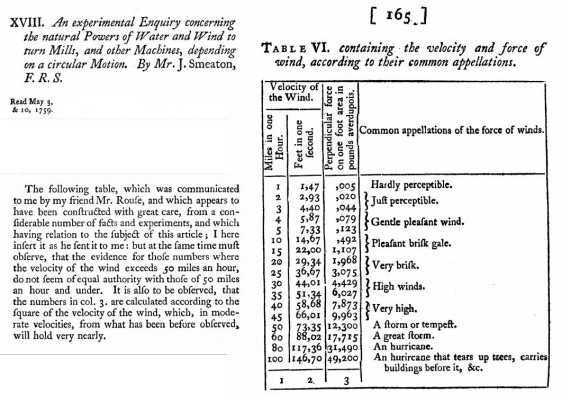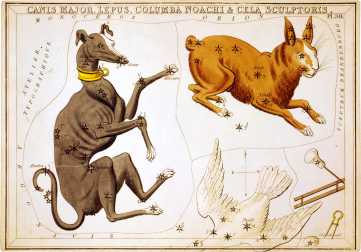Samuel Rouse (c1705–1775)
Samuel Rouse lived in Market Harborough. His occupation is given as mercer and draper (both concern textiles). His son Rowland described him as a "good mathematician and able astronomer, as well as an ingenious Mechanic" (Nichols, 1798, p484). Unfortunately he seems not to have been so good at running his business, because he was declared bankrupt in 1774 and died on January 14th, 1775.
It is likely that his grandson, Richard Rouse Bloxam (1765–1840), was responsible for a set of cards depicting the constellations called Urania's Mirror.
One of Richard Rouse Bloxam's sons, Matthew Holbeche Bloxam (1805–1888), built his own three storey house within sight of Rugby School which included a turret for his Dollond telescope.
(More information about Samuel Rouse's family and descendants.)
Observations and Experiments
In "Observations Made at Leicester on the Transit of Venus Over the Sun, June 3, 1769", William Ludlam writes, "The latitude of Market Harborough, in Leicestershire, from the mean of several accurate observations of the Sun's image, projected into a dark room, by S. Rouse: 52° 28' 30" ".
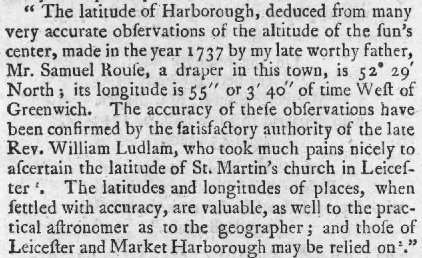 Rouse's determination of the latitude and longitude of Market Harborough confirmed by William Ludlam.
|
Account written by Samuel Rouse's son, Rowland Rouse (Nichols, 1798, p486). In 1737 he says that Samuel Rouse measured the latitude of Harborough to be 52° 29' North and the longitude 55' or 3' 40" of time West of Greenwich. Note: 3 minutes 40 seconds of time measured as an angle is 55' (minutes) not 55" (seconds) as printed in Nichols, 1798. From Google Maps, the co-ordinates of St Dionysius Church in Market Harborough are: 52° 28' 42"N, 0° 55' 17" W |
Wind Velocity and Force
|
Rouse's table on the velocity and force of wind in Smeaton's 1759
paper (Philosophical Transactions, 1759 vol. 51 pp164-5)
|
|
In his 1759 paper, "An Experimental Enquiry concerning the Natural Powers of Water and Wind to Turn Mills, and Other Machines, Depending on a Circular Motion", John Smeaton, wrote of "my friend Rouse" and describes him as "an ingenious gentleman of Harborough in Leicestershire" (p139). Samuel Rowse had "set about trying experiments on the velocity of the wind, and force therefore upon plain surfaces and windmill-sails". Table VI "containing the velocity and force of wind, according to their common appellations" (p165) had been sent to Smeaton by Rouse. This lead to Smeaton's Coefficient in equations for lift and drag. The Wright brothers used a revised version of Seaton's Coefficient in the 1900s. In 1759 John Smeaton was awarded the Copley Medal by the Royal Society " On account of his curious Experiments concerning Water-wheels and Wind-mill Sails, communicated to the Society. For his experimental enquiry concerning the powers of water and wind in the moving of Mills." Click on image for larger version. |
Age at death
In 1693 Edmond Halley (1656–1742) published an analysis of age at death which influenced the development of actuarial tables by insurance companies. Samuel Rouse gathered statistics of births, marriages and deaths in Market Harborough for the years 1632-1732.
Correspondence
In his son's obituary in The Gentleman's Magazine, 1823, he is listed as having as friends, and corresponding with, "Mr. Whiston, Dr Long, the Rev Wm Ludlam and Dr. Mason, Woodwardian Professor [...] Mr Richard Dunthorne, butler of Pembroke Hall..." These are:
William Whiston (1667–1752). Lucasian Professor, Cambridge 1702-10.
Roger Long (1680–1770). FRS. First Lowndean professor of astronomy and geometry, Cambridge, 1750.
William Ludlam (c1717–1788). Astronomical observations include the 1769 transit of Venus from Leicester.
Revd Charles Mason (1699?–1771). FRS. Woodwardian Professor of Geology, University of Cambridge
Richard Dunthorne (1711–1775). Butler at Pembroke College, Cambridge, astronomer and surveyor. Assistant to Roger Long.
Not in this list, but mentioned above: Rouse corresponded with John Smeaton (1724–1792), FRS, who coined the term "civil engineer".
Rouse's correspondence with other astronomers is in a bound volume in the Museum for the History of Science, Oxford. It includes letters from Richard Dunthorne and William Ludlam's preface to Astronomical observations made in St. John's College, Cambridge, 1769. Unfortunately at some point the last few pages have been torn out (Steele, 2012, p74n).
There is a letter by Charles Leadbetter (1681-1744), in the Oxford Museum of the History of Science archive, responding to "an amateur astronomer, Samuel Rouse, mercer of Market Harborough, Leicestershire. The letter is dated 20 Mar 1734 [ie 1735 New Style]..." who requests information about the times of solar eclipses in London between 1715 and 1733 (Application to PRISM for Purchase Grant, 2008). Leadbetter wrote about astronomy and mathematics and had observed a total eclipse in London in 1715.
Book of Calculations and Observations from Market Harborough
The Record Office for Leicestershire, Leicester & Rutland Catalogue lists, among the Market Harborough Archaeological and Historical Society documents: "Volume of mathematical & astronomical calculations & observations, [1732-1757 Samuel Rouse of Market Harborough?]".
The book is handwritten and has been used from one end (embossed 'C' on the cover) for astronomical observations and, turned over, from the other end (embossed 'D' on the cover) for mathematical exercises.
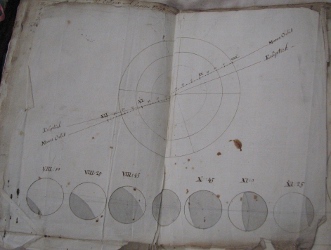 Drawings of a partial eclipse of the Sun on May 2nd, 1733 [May 13th New Style]
|
'C' includes a detailed account of a partial eclipse of the Sun on May 2nd, 1733 [May 13th New Style] and a lunar eclipse in Harborough in March 1736. The edge of the page for the latter is missing, having been trimmed. A lunar eclipse occurred on March 15 1735-6 [Mar 27 1736 New Style]. Both are illustrated with drawings, in ink, that are accurate circles, not rough sketches. There are also details of other eclipses, consisting of figures, not illustrations. |
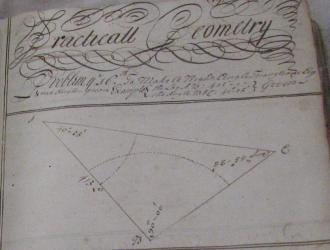 One of the exercises in geometry.
|
'D', the other side of the book, contains beautifully written and illustrated exercises in geometry. |
Urania's Mirror
Samuel Rouse's daughter, Susannah Rouse (1736/7–1804), married Richard Bloxam (1741–1825), who was born in Hinckley. Their eldest son Richard Rouse Bloxam (1765–1840) was under-master at Rugby School for thirty-eight years and rector of Brinklow, Warwickshire and vicar of Bulkington, Warwickshire. (More information about the Rouse family.)
|
Canis Major, Lepus, Columba Noachi and Cela Sculptoris, plate 30 in Urania's Mirror (Wikipedia) |
Urania's Mirror is a set of cards showing the constellations which were published around 1825. Research by Peter Hingley has shown that the author of the cards was probably Richard Rouse Bloxam. However, it appears he wished to remain anonymous, because the author named on the cards is "A Lady". In 1830 Richard Rouse Bloxam was elected a Fellow of the Royal Astronomical Society. He is named as the author of Urania's Mirror on the proposal. Those proposing him for Fellowship included William Pearson and Thomas Belgrave. William Pearson was Rector of South Kilworth, Leicestershire and one of the founders of the Royal Astronomical Society. Thomas Belgrave (c1788–1854) was Rector of North Kilworth and had been elected a Fellow in 1821, also proposed by Pearson. |
References
Davies, J. C., Georgian Harborough, 1969.
Gentleman's Magazine, The, Volume 44, November, 1774. "Bankrupts", p543.
Gentleman's Magazine, The, Vol 134, July 1823. "Obituary - Mr Rowland Rowse", p88-9.
Ludlam, William, "Observations Made at Leicester on the Transit of Venus Over the Sun, June 3, 1769", Phil. Trans. 1769 59. p240.
NASA: Path of solar eclipse of May 13, 1733 .
Nichols, John, The History and Antiquities of the county of Leicester, vol 2 part 2, 1798: Rouse family monumental inscriptions at St Mary in Arden and account of life by son, Rowland p484, determination of the latitude and longitude of Market Harborough p486, paid for church clock dial, 1729 p495, c1732 listed births, marriages and deaths for previous hundred years p499. drawing of St Mary in Arden opposite p478 drawing of St Dionysius opposite p494
Smeaton, John, "An Experimental Enquiry concerning the Natural Powers of Water and Wind to Turn Mills, and Other Machines, Depending on a Circular Motion", Phil. Trans. 1759 51 100-174. Rouse is mentioned on p139 and p164.
Steele, John M., Ancient Astronomical Observations and the Study of the Moon's Motion (1691-1757), Springer, 2012. Samuel Rouse pp74-6. [Restricted access.]
Urania's Mirror
Hingley, P. D., "Urania's Mirror - a 170-year old mystery solved?", Journal of the British Astronomical Association, 104, p238
Ridpath, Ian, Urania's Mirror - a page about the cards with images.
Correspondents
Richard Dunthorne
Clerke, A. M. , 'Dunthorne, Richard (1711–1775)', rev. Anita McConnell, Oxford Dictionary of National Biography, Oxford University Press, 2004 [http://www.oxforddnb.com/view/article/8298, accessed 29 Sept 2012]
Wikipedia: Richard Dunthorne
Charles Leadbetter
Bryden, D. J. , 'Leadbetter, Charles (1681–1744)', Oxford Dictionary of National Biography, Oxford University Press, 2004; online edn, Jan 2008 [http://www.oxforddnb.com/view/article/16233, accessed 29 Sept 2012]
Leadbetter, Charles, Astronomical Tables, 1742.
A 2008 Application to PRISM for Purchase Grant mentions Charles Leadbetter's letter to Samuel Rouse. [Google cache]
Museum of the History of Science, Oxford Inv. 11523 - additional notes on Leadbetter mentions "The single manuscript Leadbetter item in the Museum's collection is a letter to an amateur astronomer." but does not say to whom Leadbetter was writing.
Roger Long
Taub, Liba , 'Long, Roger (1680–1770)', Oxford Dictionary of National Biography, Oxford University Press, 2004 [http://www.oxforddnb.com/view/article/16975, accessed 29 Sept 2012]
Wikipedia Roger Long
Platts, Charles , 'Ludlam, William (bap. 1717, d. 1788)', rev. H. K. Higton, Oxford Dictionary of National Biography, Oxford University Press, 2004 [http://www.oxforddnb.com/view/article/17160, accessed 13 Sept 2012]
Charles Mason
The Reverend Charles Mason (1699?–1771), became the second Woodwardian Professor of Geology at the University of Cambridge in 1734. He was elected a Fellow of the Royal Society in 1742.
On his tomb at St Andrew's Church, Orwell, Cambridgeshire, he is described as Senior Fellow of Trinity College, Woodwardian Profeſſor of Foſſils [Professor of Fossils], F.R.S. and Rector of Orwell.
Note: He is not Charles Mason (1728–1786) the British astronomer after whom the Mason-Dixon line in the United States is named.
John Smeaton
Skempton, A. W. , 'Smeaton, John (1724–1792)', Oxford Dictionary of National Biography, Oxford University Press, 2004; online edn, Sept 2010 [http://www.oxforddnb.com/view/article/25746, accessed 29 Sept 2012]
Wikipedia: John Smeaton
Snobelen, Stephen D., 'Whiston, William (1667–1752)', Oxford Dictionary of National Biography, Oxford University Press, 2004; online edn, Oct 2009 [http://www.oxforddnb.com/view/article/29217, accessed 29 Sept 2012]
Wikipedia: William Whiston
Note:
The online version of the Oxford Dictionary of National Biography is available to members via City of Leicester Libraries Online Reference Room and Leicestershire County Council Libraries Online Reference Library.
Last updated 25th July, 2013.

